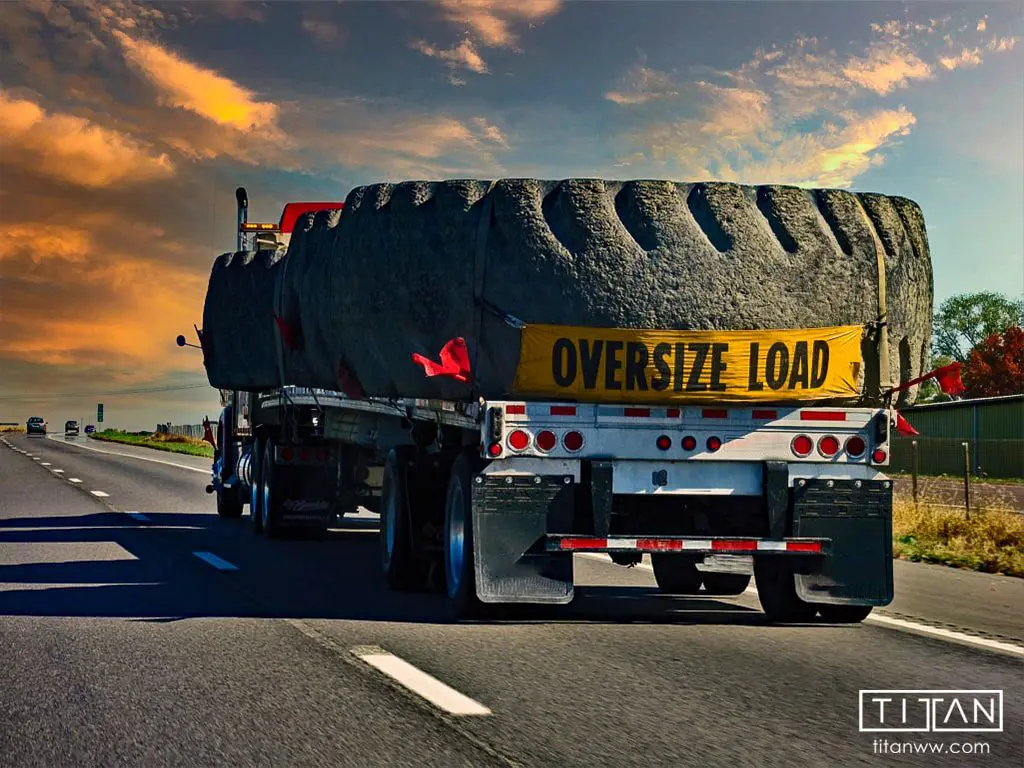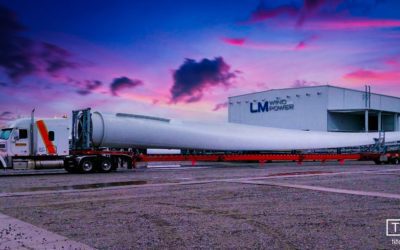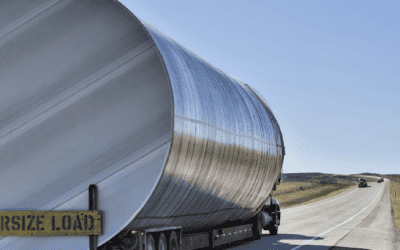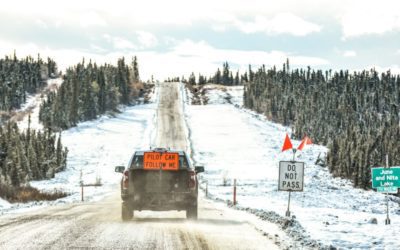Oversize Load Hauling: Using Flatbeds & Step-Decks
If nobody had invented flatbeds and side-decks long ago — our society would most likely still be struggling with oversize load hauling. Flatbeds are one of the most versatile hauling trailer types and the most common within the oversize load hauling industry.
This article is going to cover the two most common types of flatbeds which are the standard flatbed and then the step-deck flatbed. When both are properly loaded and secured, a flatbed can transport virtually anything with ease.
Standard Flatbed Trailer Dimensions
Standard flatbed trailers are generally 48 feet long and 8.5 feet wide, and take on a long rectangle shape. These trailers provide more than 400 square feet of surface to support a load. It’s important to note that flatbed trailers don’t have any walls or a roof — which actually allows cargo and equipment to overhang on the trailer (to a certain limit, of course). The top of the flatbed is generally 58 inches above the road surface.
Flatbed trailers can be used to transport several smaller cargoes and packages, but more often, you’ll see them used to transport heavy or irregularly sized equipment. Items transported on flatbed trailers are most often qualified as “oversized” and are still subject to requiring special permits/procedures before transporting.
Step-Deck Trailer Dimensions
Just like with the standard flatbed trailer, step-decks don’t have walls or a roof. Unlike a standard flatbed — which is pretty much a singular large plank — a step-deck consists of a higher and lower hauling deck that almost looks like a staircase step.
The shorter forward and upper deck is commonly 10 to 13 feet long, and about 5 feet from the ground. The lower deck is between 38 to 40 feet and only about 3.5 feet above the ground. The width of the upper and lower deck are the same, and is commonly 8 feet. With the legal load height limit being between 13.5 to 14.5 feet — that means that the lower deck can carry a load that is slightly more than 9 to 10 feet high without requiring any oversize load hauling permits. Side-deck trailers may also be referred to as “drop deck” or “open deck” trailers.
What Flatbeds and Side-Decks Carry
Being used to most commonly carry oversized loads, flatbeds and side-decks carry similar things. These include:
- Construction equipment (e.g. bulldozers, lifts, loaders, backhoes)
- Auto parts
- Farm equipment
- Industrial equipment
- Solar power equipment
- Military equipment
- Pre-built homes (and other pre-built buildings)
- Raw material (e.g. logs, lumber, stone)
- Construction material
- Vehicles
- Tubing
- Generators
Flatbeds and side-decks can both carry so much more than what we listed. Interested in oversize load hauling for your business? Give us a quick call and we’ll see if we can help you transport your items.
Flatbed vs Step-Deck
Standard flatbeds and step-decks are both common equipment within the heavy transport industry. Most drivers are familiar with both forms of trailers and are trained to work with these specific trailers. There are other flatbed-esque trailers (e.g. low-boy, Conestoga), but they often have more specialized purposes and will not be included in our discussion.
Let’s begin with similarities between flatbeds and step-decks. As mentioned, both are versatile pieces of equipment. The open designs allow easy loading and unloading of various equipment without much struggle. Both types of flatbeds also share the same standard length of 48-53 feet and both hold a maximum weight of 48,000 lbs.
The difference comes with height.
Step-decks may sometimes be considered the better option if height plays a relevant factor. With the step-deck’s lower deck, you will be able to transport slightly taller equipment while keeping transportation logistics to a minimum. The lower deck is about 2 – 2.5 feet lower than that of the traditional flatbed. If you’re able to “save” some height and avoid surpassing height load limits, you can save yourself extra charges from special permits/procedures.
Classifying Your Load
One of the most prominent features of flatbed-type trailers is that there are no walls or roofs. Being designed this way, they are perfect for transporting oversized loads that would typically extend beyond the edges of regular walled and roofed trailers. Flatbed trailers are the go-to trailers for transporting items that are excessively wide, long, or tall.
But, the nature of these items can lead to problems if certain factors are not weighed and considered. Here are the different classifications for a load, which will help you understand the oversize load hauling process better.
Oversize Loads
What exactly is oversize load hauling, and why does it matter in the first place? An oversize load is any load that exceeds the federal and/or state specified maximum legal width, height, and/or length permitted on loads. Each state has varying height and length regulations, but the width regulations are pretty much universal.
So, let’s cover the width limit first. Any load that exceeds 8.5 feet in width on major highways, or over 8 feet on secondary roads, is considered an oversized load.
Generally, the maximum height for regular loads ranges between 13.5 to 14.5 feet. Depending on how many states you need to cross to transport your cargo, a permit may be required. For instance, let’s say you need to transport cargo that is 14 feet in height. You’ll be okay without a permit in a state where the maximum height is 14.5 feet, but you’ll need a permit when passing through another state where the maximum height is only 13.5 feet.
Finally, the legal length of loads is typically between 48 to 53 feet depending on the state. Loads may overhang the end of the trailer by some length without being labeled oversized for permitting purposes. This factor varies from state to state and depends on the type of equipment being transported itself.
Superloads
“Superloads” are the next tier of oversized loads. For a fair reason, these loads require even more preparation and permits than oversized loads. Loads, in most states, that are more than 16 feet wide, 16 feet tall, and/or 160 feet long are considered a superload. Preparations associated with superloads include (but are not limited to) route surveys, specific highways routes, restricted travel times, and a variety of escort vehicles. In terms of permits, the process to obtain a superload permit is often longer than that of an oversize load hauling permit.
Overall, transporting a superload will require more time and money than oversized or legal loads. However, it is important to note that flatbeds are still the most effective and cost-efficient means to transfer superloads.
Overweight Loads
There are also overweight loads to consider. For a load to qualify as “overweight” — the combined weight of the truck and cargo will need to exceed over 80,000 lbs. Many oversized loads are also overweight loads, but there are exemptions to this claim. Besides the 80,000 lb limit, each axle pair of the vehicle can only hold 34,000 lbs. Unevenly-distributed cargo can be considered overweight despite weighing less than 80,000 lbs because of this axle pair limit. Some flatbed trailers are equipped with re-adjustable axles that can be used to redistribute the load and help you avoid having your cargo classified as ‘overweight”. Like oversize loads, overweight loads require a special permit before being transported. Special highways designed for heavy equipment that exceeds 80,000 lbs will need to be used for transportation.
Fees for overweight cargo increase proportionately with the weight of the cargo itself and depending on the state it is traveling through.
Permitting for Oversize Load Haulers
Before working with a oversize load hauling company, you will first need to obtain accurate dimensions and weights for your specific equipment or cargo, along with a planned route of travel. When you share these dimensions with an experienced transportation company, they’ll know if a permit is necessary and what kind of permits to get.
As a transportation company, you will likely deal with oversize, overweight, and even the occasional superload with time. If you and your team are struggling with the permitting process, it may be a viable option to work with an agency that’s experienced in obtaining permits.
Ensuring Proper Loading for Oversize Load Hauling
The key requirements to any successful flatbed loading are load stability, weight distribution, and proper securement. The main way to ensure that transportation goes smoothly is to follow the Federal Motor Carrier Safety Administration’s (FMCSA) rules of securing cargo. These rules are necessary to reduce the number of accidents caused by heavy cargo shifting or completely falling off of the flatbed.
The FMCSA requires cargo to be secured by structures (e.g. chains, nets, ropes, tie-downs) of sufficient strength. Cargo that is likely to shift and roll needs to be secured and held in place by equipment such as wedges, and chocks, and then chained up to prevent rolling. Cargoes such as bricks, blocks, and wood need to be secured using pallets, and then the pallets need to be secured as well. Further, there are also specific strength requirements for tie-down straps and chains that must be followed to safely secure loads.
All and all, loads must be properly secured to protect the load and also the road and pedestrians. Proper loading must not be neglected, and a transportation company must take the appropriate steps to follow industry safety standards.




